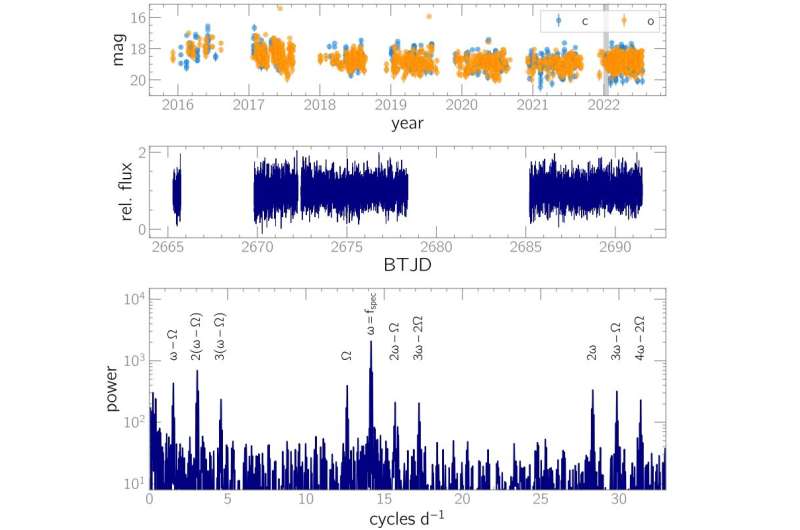January 25, 2023 report
This article has been reviewed according to Science X's editorial process and policies. Editors have highlighted the following attributes while ensuring the content's credibility:
fact-checked
preprint
trusted source
proofread
Astronomers discover a peculiar cataclysmic variable star

Using NASA's Transiting Exoplanet Survey Satellite (TESS), astronomers have discovered a peculiar cataclysmic variable star. The newly found system, designated SDSS J134441.83+204408.3 (or J1344 for short) is a highly asynchronous, short-period magnetic cataclysmic variable, despite its high surface field strength. The finding is reported in a paper published January 13 on the arXiv preprint server.
Cataclysmic variables (CVs) are binary star systems consisting of a white dwarf primary that is accreting matter from a normal star companion. They irregularly increase in brightness by a large factor then drop back down to a quiescent state. Polars are a subclass of cataclysmic variables distinguished from other CVs by the presence of a very strong magnetic field in their white dwarfs.
When white dwarfs in CVs have a field strength over 10 MG, it is expected to synchronize its rotational frequency to the binary orbit frequency, due to the steep radial dependence of the magnetic field. However, a team of astronomers led by Colin Littlefield of the Bay Area Environmental Research Institute in Moffett Field, California, reports the detection of a cataclysmic variable that defies these expectations, therefore challenging current theoretical models.
"What makes J1344 remarkable is the combination of three parameters: its moderately high magnetic-field strength, its short orbital period, and its high degree of asynchronism. Together, these properties paint an interesting picture of a magnetic CV that would normally be expected to be synchronous, but isn't," the researchers explained.
At a distance of some 1,950 light years, J1344 was initially classified as a synchronous polar. The new TESS data indicate that J1344 has a high surface field strength of about 56 MG, short orbital period of some 114 minutes and therefore also a relatively short orbital separation. Furthermore, the new observations found that this system showcases an asynchronous rotation as its spin-to-orbit ratio is at a level of 0.893, which is unusual for magnetic CVs.
The astronomers underlined that the highly asynchronous rotation in J1344 is a challenge for theoretical studies of spin-period evolution. They noted that it proves that a surface field strength higher than 10 MG and short binary separation does not guarantee that a system will rapidly synchronize.
All in all, the researchers suppose that some combination of a weakly magnetic secondary star or an unusually massive white dwarf is the most plausible hypothesis that could explain the failure of J1344 to achieve synchronous rotation. According to them, the case of J1344 suggests that some other CVs classified as synchronous polars need to be revisited as they may be asynchronous systems.
"J1344's ability to successfully masquerade as a synchronous polar for a decade suggests that other nominally synchronous systems might also be asynchronous. It will be important to examine the TESS light curves of all polars to search for any such systems," the authors of the paper concluded.
More information: Colin Littlefield et al, SDSS J134441.83+204408.3: A highly asynchronous, short-period magnetic cataclysmic variable with a 56 MG field strength, arXiv (2023). DOI: 10.48550/arxiv.2301.05723
Journal information: arXiv
© 2023 Science X Network




















